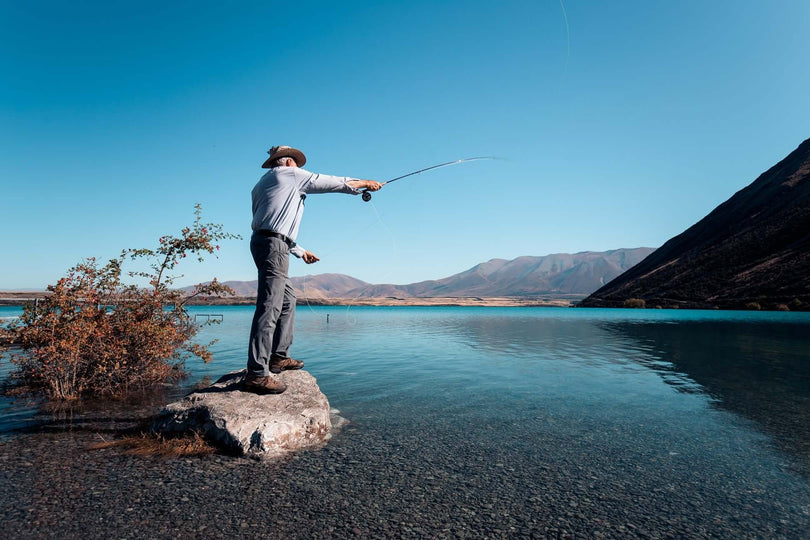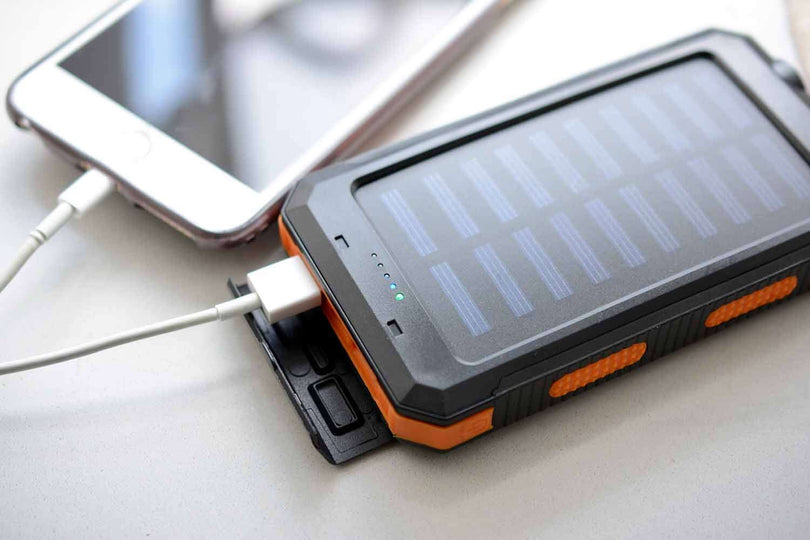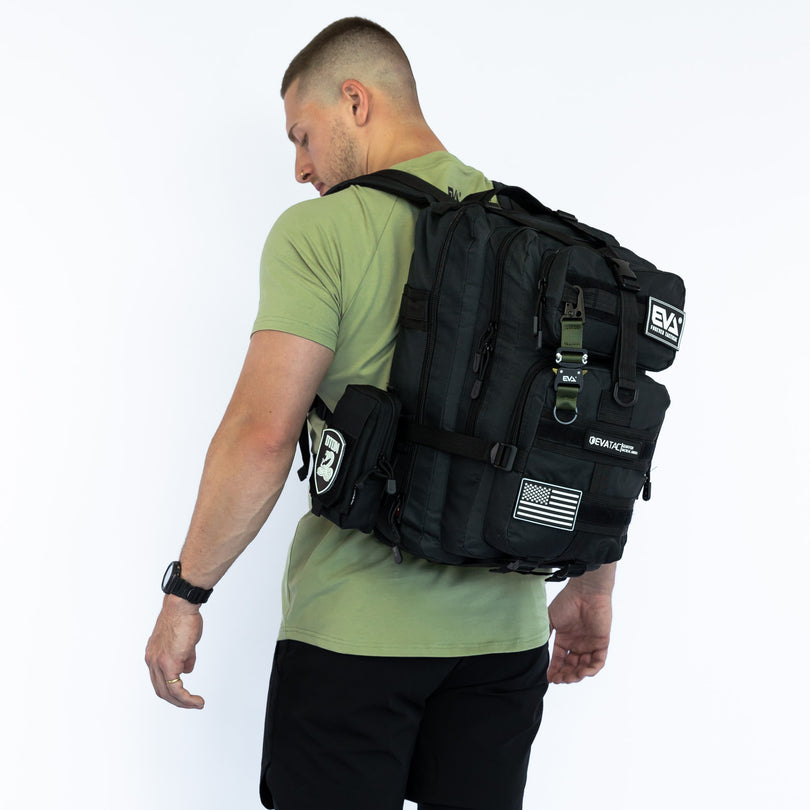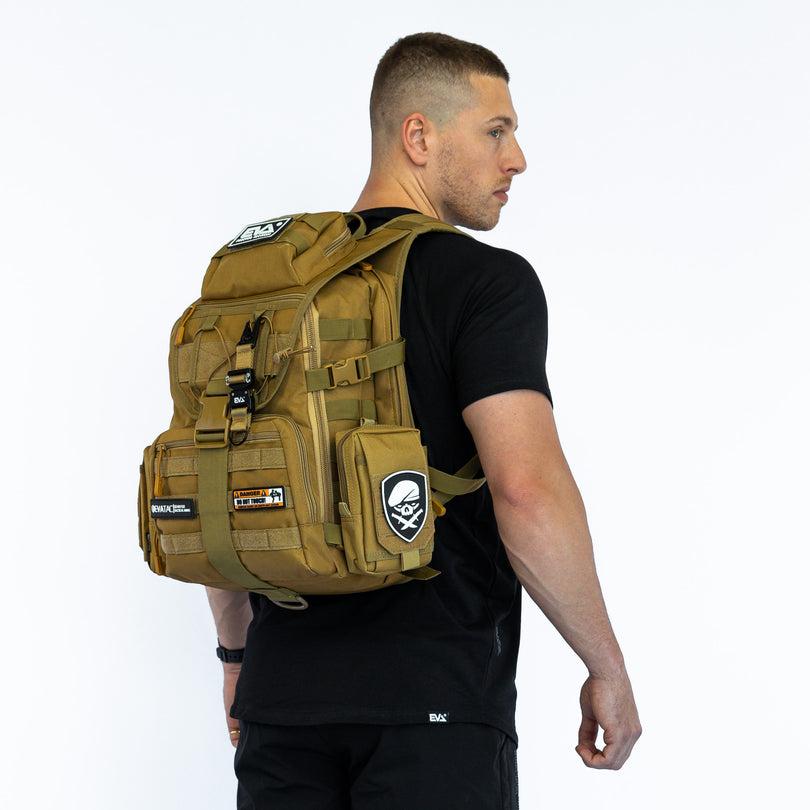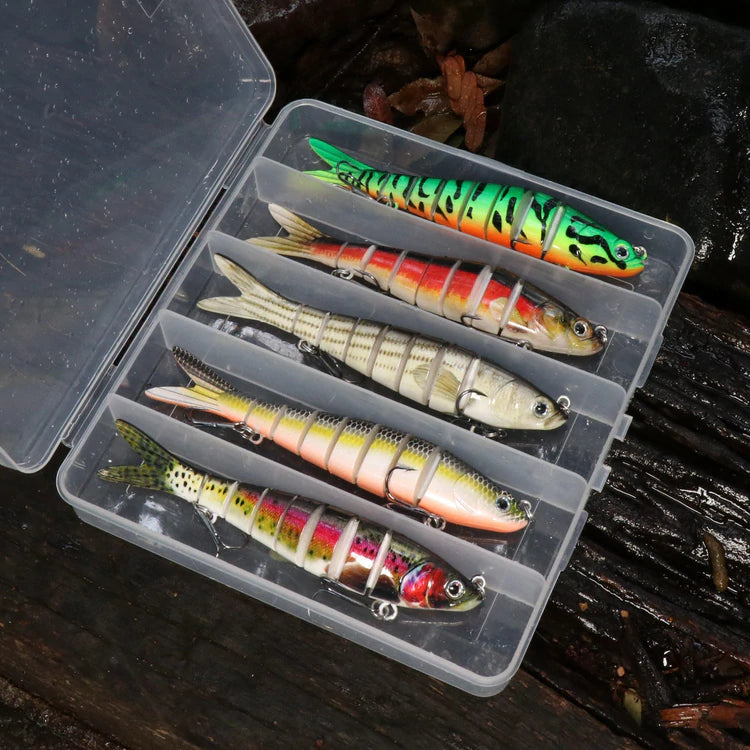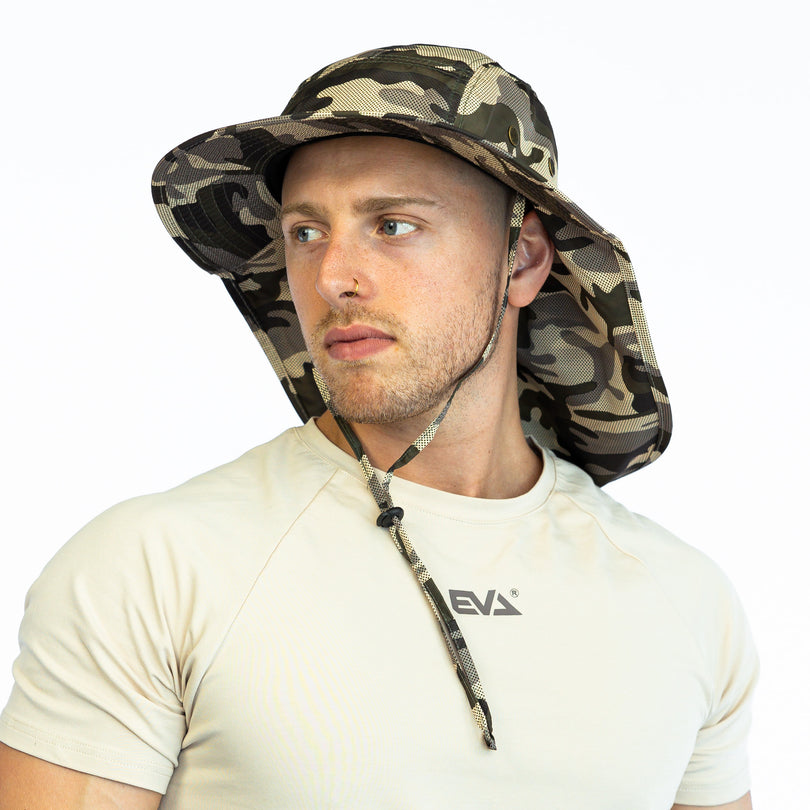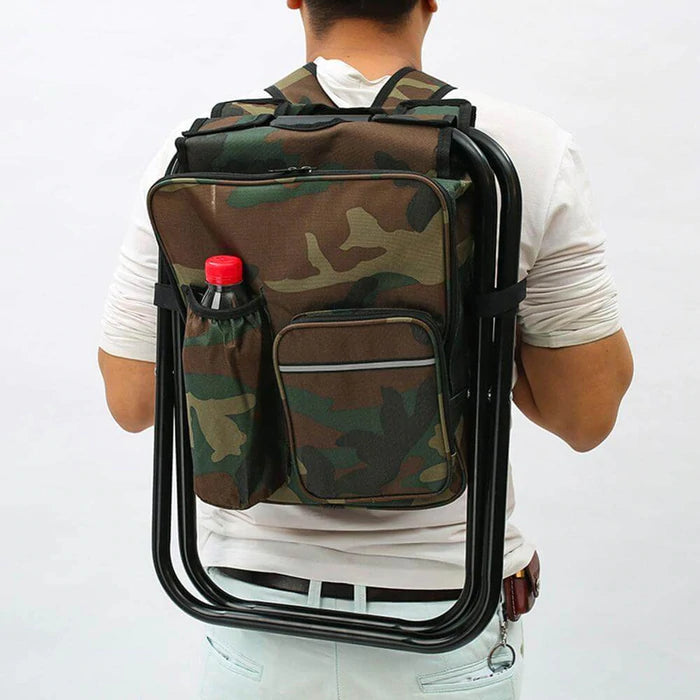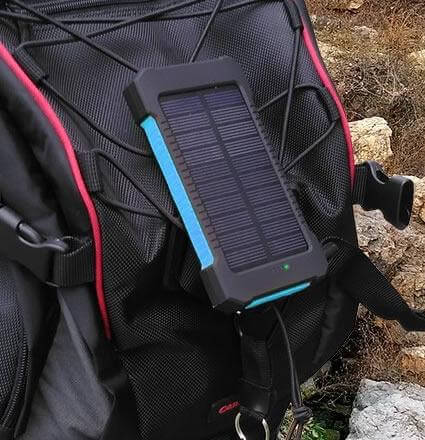Do you love spending time fishing on freshwater lakes, ponds, and streams but could use a little help catching more fish? If so, you're in luck! If you're new to freshwater fishing, or just looking to up your game, this extensive guide will teach you everything you need to know about using lures to catch more fish. We'll cover the different types of fishing lures that work well in freshwater, as well as how to use them effectively. By the end of this guide, you'll be an expert on using lures to catch fish in no time!
What Attracts Fish The Most?
When using lures in freshwater and saltwater fishing, one of the most important things to understand is what attracts fish. While there are a variety of factors that can attract a fish, some of the most common include:
Motion
Fish are attracted to lures that move in the water. This movement simulates the motion of prey, which will trigger a fish's instinct to hunt. Motion is also a great way to get a fish's attention, especially in murky or dark water.
This is why fishing baits that wobble or spin are often so effective. The motion of these fishing lures in the water is similar to that of a wounded fish, which will trigger a predatory response in many types of fish. Predator fish usually prefer lures that move quickly, while prey fish tend to be attracted to slower-moving lures.
Colour
Bright colours are often more visible in murky water, so they can be effective in attracting fish. However, it's important to note that different species of fish are attracted to different colours. For example, the bass is typically attracted to dark colours like black and blue, while trout tend to be drawn to brighter colours like red and yellow.
Many anglers experiment with different colours to see what works best for the type of fish they're trying to catch. The safest way to do this is to secure your fish tackle box with different colours of fishing lures so that you're prepared for anything.
Sound
Many types of fish are attracted to the sound of fishing lures as they move through the water. This sound is often produced by the materials the lure is made of, such as metal or plastic. In some cases, fishing lures are designed to make specific sounds that attract fish.
For example, many rattling objects such as soft plastic fishing lures are designed to mimic the sound of prey running away from a predator. Chatter baits are another type of fishing lure that produces sound, often by clicking two pieces of metal together. This sound is meant to imitate the struggle of a fish fighting to free itself from a predator's mouth.
Scent
Many fishing lures are designed to release scent into the water to attract the fish species. Scented lures are especially effective in still or slow-moving water, where the scent has time to disperse. Some common scents used in fishing lures include garlic, anise, and shrimp.
Now that you know what attracts fish, let's take a look at some of the different types of freshwater lures that you can use to catch them.
What Fishing Lures Should I Use For Freshwater Fishing?
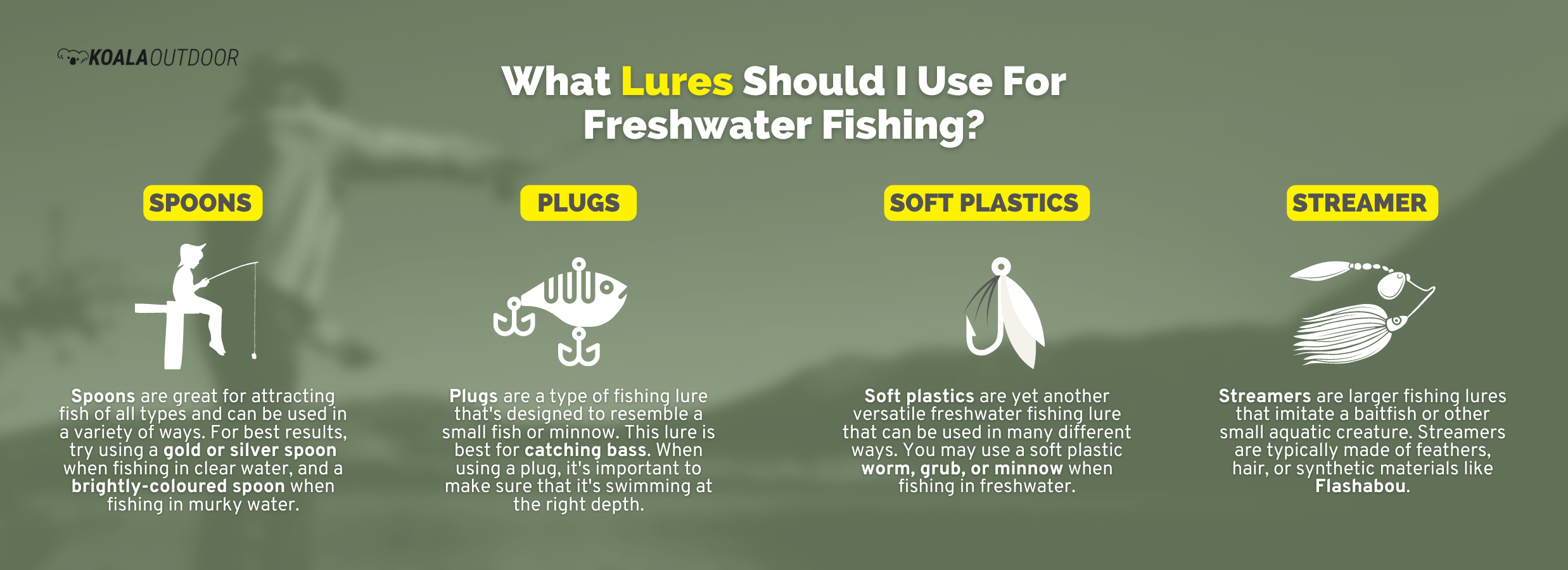
Fishing lures come in all shapes, sizes, and colours, which can make it tough to decide which ones to use. But don't worry - we're here to help! Here are a few of the most popular types of lures that work well in freshwater:
Spoons
Spoons are one of the most versatile and effective fishing lures out there. They're great for attracting fish of all types and can be used in a variety of ways. For best results, try using a gold or silver spoon when fishing in clear water, and a brightly-coloured spoon when fishing in murky water.
Spoons are one of the most popular trout lures. It is often designed to mimic the movement of a small fish or minnow. Trout lures tend to do best in cold water and are often used in rivers and streams. Make sure you check the regulations in your area before using trout lures, as there are often restrictions on the size and type of lure you can use.
Plugs
Plugs are a type of fishing lure that's designed to resemble a small fish or minnow. They're one of the best lures for catching bass, but can also be used to catch other types of fish. When using a plug, it's important to make sure that it's swimming at the right depth - too deep and the fish won't see it, but too shallow and they'll ignore it.
Soft Plastics
Soft plastics are yet another versatile fishing lure that can be used in many different ways. They're often used in combination with other fishing lures, such as jigs or spoons, to create an irresistible baitfish imitation that fish just can't resist.
You may use a soft plastic worm, grub, or minnow when fishing in freshwater. If you're not sure which one to use, try a few different types and see what works best for the type of fish you're trying to catch.
Streamer
Another popular type of fishing lure is the streamer. Streamers are larger fishing lures that imitate a baitfish or other small aquatic creature. They're often used to catch trout, bass, and other predatory fish. Streamers are typically made of feathers, hair, or synthetic materials like Flashabou.
Each type of fishing lure has its own unique set of benefits that can help you catch more fish. For example, spinnerbaits are great for attracting fish with their flashy blades, while crankbaits are perfect for reaching deep areas where fish may be hiding. Plugs are another versatile option that can be used in a variety of ways, and soft plastics are ideal for imitating live baitfish.
Now that you know what types of fishing lures work best in freshwater, let's take a look at how to use them effectively...
What Are The Best Lures For Lake Fishing?
If you're looking for the best lures for lake fishing, there are a few things you'll want to consider. First, think about the type of fish you're hoping to catch. Different species of fish are attracted to different types of lures. For example, the bass is attracted to crankbaits and spinnerbaits, while trout are more likely to bite on a spoon or soft plastic. Once you know what kind of fish you're after, you can narrow down your choices and choose the best lure for the job.
Spinnerbaits are one type of lure that works well in lake fishing. They're designed to attract fish with their flashy blades, which spin as the bait is pulled through the water. Bass and trout are two fish species that are attracted to spinnerbaits, making them a great choice if you're hoping to catch either of these species.
A shallow lure is another great option for lake fishing. This type of fishing lure is designed to float on the surface of the water, making them ideal for targeting fish species that are feeding near the top. Some of the best shallow lures for lake fishing include topwater baits, buzz baits, and swimbaits.
Once you know what kind of fish you're after, you can narrow down your choices and choose the best lure for the job. Bass lures, for example, should be shiny and brightly coloured so that they can attract the bass' attention.
By considering these factors, you can choose the best lures for lake fishing and increase your chances of success. So, what are you waiting for? Get out there and give it a try! Freshwater fishing is a great way to relax and enjoy the outdoors, and with the right lure, you can have a lot of success.
How Do I Use Freshwater Lures?
Now that you know what types of lures work best in freshwater, it's time to learn how to use them effectively. Freshwater fishing lures are different from traditional baits since they are designed to imitate a small creature or baitfish. This makes them more attractive to fish, as they think they're getting an easy meal.
Here are a few tips on how to use freshwater fishing lures:
- Pay attention to the water depth and choose a lure accordingly. For example, if you're fishing in shallow water, you'll want to use a lure that doesn't sink too deeply.
- Consider the type of fish you're trying to catch. Different species of fish are attracted to different types of lures. For example, the bass is attracted to crankbaits and spinnerbaits, while trout are more likely to bite on a spoon or soft plastic.
- Vary your retrieve speed. Sometimes, fish will respond better to a fast retrieval, while other times they'll prefer a slower pace. It's important to experiment and see what works best in each situation.
- Pay attention to the condition of the water. If it's murky, you'll want to use brighter-coloured lures so that the fish can see them. In clear water, on the other hand, natural-looking lures tend to work best.
By following these tips, you'll be well on your way to catching more fish the next time you go freshwater fishing. So, what are you waiting for? Get out there and give it a try! Freshwater fishing is a great way to relax and enjoy the outdoors, and with the right lure, you can have a lot of success. Good luck!
What To Use To Fish In A River?
Fishing in a river is a different experience than fishing in a lake. The current can be much stronger, the water may be murky, and there may be debris in the water. All of these factors can affect what type of lure you use.
If you're new to fishing or if you're fishing in a river for the first time, it's always a good idea to talk to a local bait and tackle shop before heading out. They'll be able to give you more specific advice based on the river you'll be fishing in and the type of fish you're hoping to catch.
Some trusted fishing gear that you can use in a river are:
Spin cast reel
The spin cast reel helps in easy and efficient luring in the river. It works by the force of the water and doesn’t require too much effort from the fisherman. This type of reel is easy to use and perfect for beginner anglers.
Baitcasting reel
The baitcasting reel is a bit more complicated to use but it’s very effective in luring fish. It uses the weight of the lure to cast out into the water. This type of reel is perfect for experienced anglers who have a good handle on their luring techniques.
Spinning reel
The spinning reel is great for lighter lures and works by using a spinning motion to cast out the line. This type of reel is perfect for anglers who want to use smaller lures to attract fish.
Crankbaits
Crankbaits are another great option for freshwater fishing. They come in a variety of sizes and colours, so you can find one that's perfect for the type of fish you're trying to catch. When using a crankbait, be sure to reel it in at a steady pace - too fast and the fish won't be able to bite, but too slow and they'll lose interest. Building your fishing tackle box with a variety of crankbaits is a great way to be prepared for any situation.
Sinkers
Sinkers are used to help weigh down your line so that it sinks to the bottom of the river where the fish are. The size and weight of the sinker you use will depend on the depth of the river and the strength of the current.
Monofilament line
A monofilament line is a type of fishing line that's made from a single strand of material. It's strong and durable, making it a good choice for fishing in rivers. Lure fishing with this type of fishing line is also popular because it's less likely to get tangled than other types of fishing line.
Braided line
A braided line is made from multiple strands of material that are braided together. It's extremely strong and can be used in rivers with heavy currents. This can be used in both freshwater and saltwater fishing and is also a good choice for anglers who want to use heavier lures.
Fluorocarbon line
A fluorocarbon line is made from a type of material that's similar to monofilament, but it's much less visible in the water. This type of fishing line helps in hiding the lures from the fish, making it a good choice for clear rivers.
Hooks
In lure fishing, you'll need a sharp hook so that you can effectively catch fish in a river. Hooks are most efficient in moving water because the current helps to set the hook in the fish's mouth. The size of the hook you use will depend on the type of fish you're hoping to catch. Some common hooks used for river fishing are:
J hooks
The J hook is a common type of fishing hook that's used for a variety of fish. It's named for its shape - the point of the hook curves back towards the shank in a "J" shape. This type of hook is often used with live bait because it helps to keep the bait on the hook.
Circle hooks
A circle hook is another common type of fishing hook that's used in river fishing. It gets its name from its shape - the point of the hook curves around in a circle back towards the shank. This type of hook is often used with live fishing baits because it's less likely to tear the bait when setting the hook.
Treble hooks
A treble hook is a type of fishing hook that has three points. It's often used with lures because it gives the fish multiple points to bite onto. When using a treble hook, be sure to check the regulations in your area - they're not legal in all waters.
Aberdeen hooks
The Aberdeen hook is a type of fishing hook that has a long shank and a small gap. It's named for the city in Scotland where it was first used. This type of fishing hook is often used with live bait because the long shank helps to keep the bait on the hook.
Baitholder hooks
The baitholder hook is a type of fishing hook that has barbs on the shank to help keep the bait on the hook. It's named for its use - holding the bait in place so that it doesn't come off of the hook. This type of fishing hook is often used with live bait because it helps to keep the bait on the hook.
Where To Buy Freshwater Lures?
Now that you know what to look for in a freshwater lure, it's time to start shopping! There are a few different places you can buy them:
- Online
- Bait and tackle shops
- Sporting goods stores
- Department stores
When shopping for freshwater lures, be sure to read the reviews to get an idea of what other anglers think. You can also ask your friends or family members for recommendations. Once you've found a few that you like, be sure to test them out in a variety of different rivers to see what works best for you. Freshwater fishing is a great way to relax and enjoy the outdoors - with the right lures, you're sure to have success!
You might be wondering what the best lures are for catching fish. The good news is that there are a variety of different fishing lures available, each with its own set of benefits. We hope this guide took you on a look at some of the best freshwater fishing lures so that you can choose the right one for your next fishing trip.
If you found this guide helpful, be sure to check out our other fishing guides for more tips and tricks. Happy fishing!






